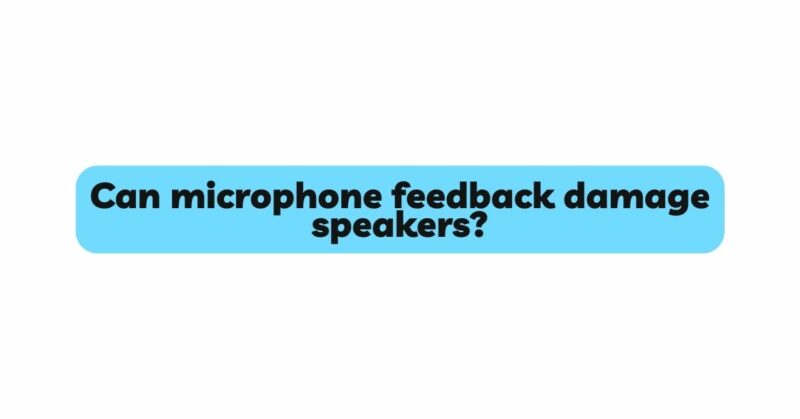In the intricate realm of audio technology, where sound waves and electrical signals intertwine to create mesmerizing auditory experiences, certain interactions can have far-reaching consequences. One such interaction that sparks curiosity is the potential impact of microphone feedback on the health of speakers. In this article, we delve into the science behind microphone feedback, the relationship between microphones and speakers, the potential risks, and the strategies to mitigate damage and maintain audio equipment longevity.
Understanding the Players: Microphones and Speakers: Before delving into the implications of microphone feedback on speakers, it’s crucial to grasp the roles and functions of these essential components in the audio chain.
Microphones are devices that transform acoustic sound waves into electrical signals. These devices contain transducers that convert the vibrations caused by sound waves into corresponding electrical variations. Microphones vary in types and designs, each catering to specific sound capturing requirements.
Speakers, on the other hand, are engineered to convert electrical signals into audible sound. They utilize diaphragms that vibrate in response to the electrical currents, creating sound waves that radiate into the environment. Speakers are carefully designed to reproduce specific frequency ranges and patterns of sound.
Microphone Feedback: The Interplay of Sound Waves: Microphone feedback occurs when the output sound from a speaker is captured by a microphone and then re-amplified through the speaker, resulting in a self-perpetuating loop. This phenomenon, known as acoustic feedback, generates a distinctive high-pitched screech.
The Feedback Loop: The feedback loop, which involves microphones and speakers, follows a sequence of steps:
- Capture: The microphone captures sound emitted by the speaker and converts it into an electrical signal.
- Amplification: The electrical signal is amplified and sent to the mixer or amplifier.
- Re-Emission: The amplified signal is transmitted to the speaker, causing the diaphragm to vibrate and generate sound waves.
- Recapture: The microphone captures the re-emitted sound waves from the speaker and converts them into a new electrical signal.
- Amplification (Again): The new electrical signal is further amplified.
- Re-Emission (Again): The amplified signal is sent back to the speaker, continuing the cycle.
Potential Impact on Speakers: Microphone feedback, when left unchecked, can indeed have detrimental effects on the health of speakers. Some of the potential impacts include:
- Distortion: The repeated amplification and re-emission of sound waves can lead to distortion and the characteristic high-pitched screech associated with acoustic feedback.
- Component Stress: The constant vibration caused by feedback can place undue stress on the speaker’s diaphragm, suspension system, and other components.
- Overheating: Continuous operation at high volumes due to feedback can lead to overheating, which may adversely affect the longevity of the speaker’s components.
- Driver Damage: The excessive movement of the diaphragm caused by feedback can cause wear and tear on the driver, potentially leading to damage over time.
Mitigation and Strategies for Protection: Sound engineers and enthusiasts have developed strategies to mitigate the potential impact of microphone feedback on speakers:
- Feedback Eliminators: Employ feedback eliminators, which are devices that analyze the audio signal and automatically apply filters to eliminate frequencies causing feedback.
- Microphone Placement: Adjust the positioning and orientation of microphones and speakers to minimize the risk of feedback.
- Directional Microphones: Use directional microphones, such as cardioid or supercardioid microphones, that are less sensitive to sound from certain directions.
- Equalization (EQ) and Filters: Apply equalization and filters to the audio signal to attenuate frequencies that are prone to feedback.
- Feedback Notch Filters: Use feedback notch filters to target and eliminate specific problem frequencies.
- Volume and Gain Control: Carefully manage the volume levels and gain settings to prevent feedback from occurring.
The Bottom Line: Protection and Preservation: Microphone feedback can indeed damage speakers if left unmanaged. However, with careful attention to the interactions between microphones and speakers, and the implementation of mitigation strategies, the potential for damage can be significantly reduced. This requires a delicate balance between capturing sound and reproducing it accurately while safeguarding the health of audio equipment.
Conclusion: In the dynamic world of audio technology, the interplay between microphones and speakers can lead to fascinating phenomena such as microphone feedback. Understanding the potential consequences of microphone feedback on speaker health is crucial for sound engineers, performers, and enthusiasts. By employing smart strategies and leveraging advancements in audio equipment, we can revel in immersive auditory experiences while preserving the integrity and longevity of our precious speakers.


